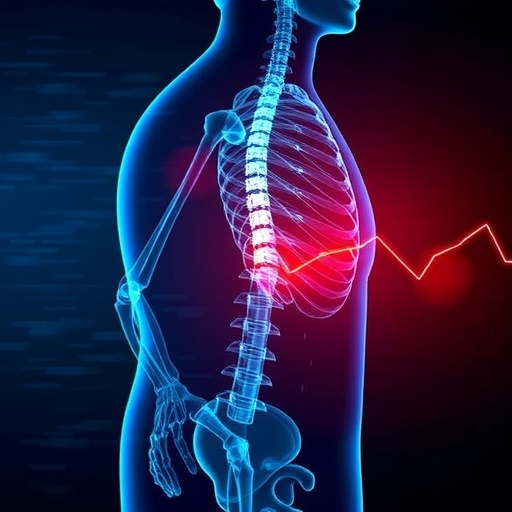Groundbreaking Study Reveals How Pulsed Electromagnetic Fields Activate Sensory Nerves to Boost Bone Formation in Aging Models
In a remarkable leap forward for regenerative medicine and aging research, a team of scientists has uncovered a novel mechanism by which pulsed electromagnetic fields (PEMFs) stimulate sensory nerve activity to promote bone formation in aging organisms. The implications of this discovery extend beyond traditional bone disease treatments, potentially revolutionizing therapies for osteoporosis and skeletal degeneration. Published recently in Nature Communications, the study offers a sophisticated interplay of neurobiology and osteogenesis that could pave the way for non-invasive interventions restoring skeletal health in elderly populations.
As humans age, skeletal rigor progressively diminishes through complex biological processes leading to osteoporosis and heightened fracture risk. Previous evidence underscored the utility of mechanical stimulation and electromagnetic therapy in promoting bone growth, but the precise cellular and molecular pathways remained elusive. The current research bridges this knowledge gap by demonstrating that PEMF’s therapeutic effects are mediated via sensory nerve regulation. This neuro-osteogenic crosstalk is key to activating osteoblast precursor cells to regenerate bone tissue, a discovery that challenges conventional wisdom focusing solely on direct cell stimulation.
The investigative team employed aging animal models to evaluate the impact of targeted PEMF exposure on bone quality and density. Through a series of imaging, molecular assays, and behavioral analyses, they revealed that PEMF induces a burst of activity in sensory nerves innervating bone tissue. These nerves release neuropeptides that interact with bone progenitor cells, catalyzing their proliferation and differentiation into mature osteoblasts. The team’s meticulous experiments delineated a causal chain from electromagnetic stimulation to neural activation and ultimately to enhanced bone matrix deposition.
At the heart of this biological cascade is the nuanced role of specific sensory neurons, which appear to act as transducers converting physical electromagnetic cues into biochemical signals capable of orchestrating bone remodeling. The discovery highlights an underappreciated dimension of peripheral nervous system contribution in skeletal maintenance, shifting the paradigm from a purely mechanical or hormonal perspective towards an integrated neurogenic framework. These neurons produce signaling molecules such as Calcitonin Gene-Related Peptide (CGRP) that fine-tune the local bone microenvironment conducive to regeneration.
Importantly, the researchers observed that aged bones typically suffer from diminished sensory innervation, potentially explaining the attenuated osteogenic capacity seen in elderly subjects. PEMF treatment partially restores this sensory nerve activity and associated neurochemical signaling, effectively reawakening the bone’s intrinsic repair mechanisms. This restoration was quantitatively verified through histological analyses demonstrating increased nerve fiber density in treated specimens compared to controls, directly correlating with improved bone mass and microarchitecture.
The interdisciplinary experimental approach combined electrophysiology with advanced genomic profiling to explore the molecular milieu influenced by PEMF-stimulated sensory nerves. Transcriptomic data revealed upregulation of genes relevant to osteogenesis and neuropeptide signaling pathways, providing a molecular blueprint for the regenerative process. Concurrently, electrophysiological recordings confirmed heightened action potentials within bone-associated nerve fibers during and post-PEMF exposure, offering functional evidence for neural engagement.
From a therapeutic standpoint, this research introduces an innovative modality that could complement or even replace pharmacologic agents currently used for osteoporosis management. Unlike drugs that often carry systemic side effects, PEMF offers a targeted, non-invasive, and potentially safer alternative to enhance bone strength via endogenous neural mechanisms. Furthermore, the approach aligns with personalized medicine principles, as the stimulation parameters can be fine-tuned according to individual neurophysiological responsiveness.
The implications extend beyond clinical therapy into fundamental aging biology. By revealing sensory nerves as critical regulators of skeletal homeostasis, the study opens avenues to investigate neural contributions to other tissue regeneration processes impaired during aging. The findings may also stimulate development of PEMF devices tailored to different anatomical sites or disease conditions, expanding the versatility and applicability of electromagnetic therapies.
While promising, researchers caution that translation of these findings into human trials requires careful calibration. Differences in nerve distribution, bone remodeling rates, and aging pathologies between animal models and humans necessitate rigorous validation steps. Nevertheless, the robust mechanistic insights provide a strong foundation for future clinical exploration aiming to harness neurogenic signals for bone repair.
In parallel, the research sets a precedent for combining bioelectromagnetic treatments with emerging biotechnologies such as gene editing or stem cell therapies. Integrative approaches could synergistically amplify the bone formation capacity, offering hope for patients suffering from severe skeletal disorders resistant to conventional treatment.
In essence, this groundbreaking study marks a new chapter in understanding the neurobiological underpinnings of bone regeneration. By elucidating how pulsed electromagnetic fields activate sensory nerve-driven mechanisms, the research redefines the therapeutic landscape for age-related bone loss. The cross-disciplinary insights merge physics, neuroscience, and orthopedics, showcasing the power of convergent science to solve pressing biomedical challenges.
As the global population ages, the burden of osteoporosis and fractures climbs steadily, underscoring the urgency for innovative interventions. Non-invasive PEMF-based therapies inspired by these findings could transform prophylactic care and rehabilitation strategies, significantly improving quality of life for millions worldwide. This elegant fusion of electromagnetic stimulation and sensory nerve regulation may indeed herald a new era in regenerative medicine, where harnessing the body’s own neural circuits becomes the cornerstone of skeletal health restoration.
Continued investigations will undoubtedly explore optimal PEMF parameters, long-term outcomes, and integration with existing treatment frameworks. Furthermore, unraveling the interplay between sensory nerves and other cell types within the bone niche promises to deepen our grasp of tissue dynamics in aging and disease. This exciting frontier holds tremendous potential, illuminating how subtle electromagnetic cues can orchestrate powerful biological outcomes via sensory neural pathways.
Ultimately, the study exemplifies the transformative impact of interdisciplinary research and technological innovation. It invites us to rethink the complex symphony of biological systems through a neuro-electromagnetic lens, opening new horizons for restoring function and resilience in aging tissues. The prospect of rejuvenating bones by tuning their sensory nerve regulators signals a paradigm shift that could redefine aging medicine and healthcare aesthetics in the near future.
Subject of Research: Sensory nerve-mediated bone formation regulation by pulsed electromagnetic fields in aging models
Article Title: Pulsed electromagnetic fields mediate sensory nerve regulation for bone formation in aging models
Article References: Wang, T., Liang, Z., Wang, C. et al. Pulsed electromagnetic fields mediate sensory nerve regulation for bone formation in aging models. Nat Commun 16, 8223 (2025). https://doi.org/10.1038/s41467-025-63703-9
Image Credits: AI Generated
Tags: Aging Animal ModelsAging ResearchCellular and Molecular PathwaysElectromagnetic Therapy for Bone GrowthNerve-Driven Bone GrowthNeurobiology and OsteogenesisNon-Invasive InterventionsOsteoporosis TreatmentPulsed Electromagnetic FieldsRegenerative MedicineSensory Nerve ActivitySkeletal Degeneration





